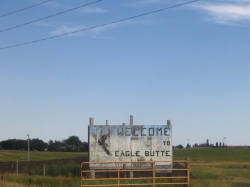The painting was static quality: horse, rider were stiff, quite upright. Signed below in flowing script is John Running Horse. Painted like by some talented twelve-year old. Still have it.
Today, replastered, equipt with a cane, John gondoliered away, dipping and rising into the horizon.
Mrs. Alpern, the head nurse, a full-blooded Sioux, asks me to round with her before settling into the apartment across the parking lot. With call every three to four nights, trips would be short. Mrs. Alpern is of solid build; broad of beam, legs akimber, she sweeps ahead, clearing the corridor like some Arctic ice-breaker, leaving a wide wake behind. The swish of her white, opaque Supp-hose as she walked lent to the sense of being wave-washed asea. Months later, Mrs. Alpern had warmed to me – the Sioux, finding the Christian missionary doctors overbearing, welcomed a Jew; I passed out birth control pills and no religion. Those months later, before I am to leave, she confides that we might be distantly related: her husband’s name she suspects came from a dry goods itinerant salesman, a Halpern, some generations back; left behind both “wet” and dry goods; perhaps she was part-Jewish by marriage; perhaps if not related, we were at least of common spirit.
The Bad Warriors’ skin was impetigo-stamped; their hide looked angry and they, both corralled in the same crib, acted angry. Scowls greeted all; food, spoons, toys, pillows, anything loose became missiles. Debby, who had wifed me through a year of internship, was put on twin-feeding duty; she got aproned and gloved before battle. I turned to the baby.
There were two pilots in Eagle Butte: Tim, a white rancher who crop-dusted; and Mr. R., the grey-skinned undertaker. Tonight, Tim would fly us out in his four-seater V-tail Beech Bonanza, what was later monikered -- shortly before production was discontinued in 1982 - the "fork-tailed doctor killer." The back two seats are removed for the baby’s incubator crib, oxygen, resuscitation equipment and myself. The baby’s crib is strapped-in tightly, like cargo. Tim asks me to take a front seat for take-off; weather’s brewing, could be bumpy.
I refuse, crouch and huddle myself over the crib. Soon, I learn bumpy: my head dribbles off the ceiling throughout the flight; a helmet would have served well. The ambu-bag and cardioverter I use thrice in the hour flight. The baby dies on landing. I hand over the Xrays and labs to the doc who greeted us in Fargo; we duly review them on the tarmac, Xrays against the sun. Tim and I head back, emptied. The storms had brewed; retribution for life lost.
By the time we approach Pierre, rain, hail and wind shears were bad enough we were told to land, not try for Eagle Butte. Winds were blowing ninety degrees to the single runway. I am now belted-in, annointed co-pilot. Tim tries to demonstrate an acrobatic landing: we fly into the wind, perpendicular to the runway. “Watch.” I must admire his maneuver as he harnesses the head-wind to shift ninety-degrees for the landing. My nodding face is tucked into a vomit bag.
On ground, sheets of horizontal rain hustle us into the waiting ambulance to take us eighty miles to Eagle Butte. Debby, I learn, had been joined by Sister Margaruite, the Roman Catholic nun and nurse. Sister had followed the weather reports. Rosary in hand, she adhered to Debby, praying for my safe return; not sounding reassuring. I, too preoccupied with a dying baby, with weather’s bluster had been oblivious to danger. Even until today, a bit oblivious.
Then, we felt timeless; we thought we would be forever.
He looks septic and dehydrated: tented skin, labored breath, eyes shut. Neither docs nor nurses could get an IV inserted. I shave the scalp, prep. Mrs. Alpern finds a #25 Butterfly needle (smallest made) and I slid this into a vein. The delicate skin reveals veins like earthworms beneath a membrane of detritused leaves. I anchor the lifeline firmly, using the coilings and tapings that I had learned at the University. Antibiotics for both gram negative and positives and some fluids appeared to brighten the baby within a few hours.
Enough time to move suitcases into the cinder-blocked Bureau of Indian Affairs apartment building across the way, have dinner at the only restaurant in Eagle Butte, return for evening rounds. This baby would not make it here. I ask Mrs. Alpern about the nearest Infant Intensive Care Unit; Fargo, some hundreds of miles away. No problem, she assures; we would be flown out.
But today, rapid-fire rounds. After a year of pediatrics, I would work as a general practitioner here; everyone on-call did snake bites, deliveries, cut men out from overturned tractors, sewed-up knife wounds. Yet, this Sunday, the most acute cases were the Bad Warrior twins and the newborn lying alone, almost agonal in a crib.


 A limp and a death among the Lakota Sioux marked my first day at Eagle Butte, devoid of eagles and buttes. Two days’ drive from Chicago, I am greeted from afar by John Running Horse, he dipping and rising like a Venetian gondolier, waving aloft what from afar seemed to be the plaster sculpture of a leg. Up close, it is.
A limp and a death among the Lakota Sioux marked my first day at Eagle Butte, devoid of eagles and buttes. Two days’ drive from Chicago, I am greeted from afar by John Running Horse, he dipping and rising like a Venetian gondolier, waving aloft what from afar seemed to be the plaster sculpture of a leg. Up close, it is.